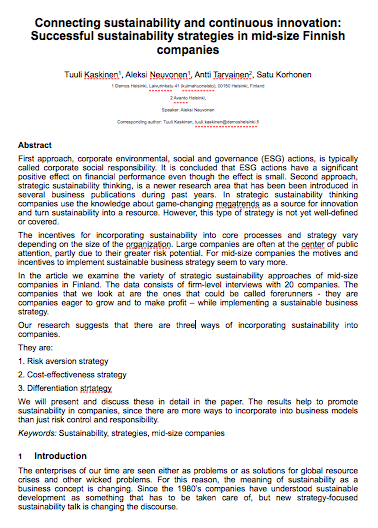Compared to large companies, substantially less attention has been paid to mid-size companies as forerunners of strategic sustainability practices. However, there are various reasons to assume that the best examples of strategic sustainability might be found amongst mid-size companies.
In the article we examine the variety of strategic sustainability approaches of mid-size companies in Finland. The data consists of firm-level interviews with 20 companies. The companies that we look at are the ones that could be called forerunners – they are companies eager to grow and to make profit – while implementing a sustainable business strategy.
The incentives for incorporating sustainability into core processes and strategy vary depending on the size of the organization. Large companies are often at the center of public attention, partly due to their greater risk potential. For mid-size companies the motives and incentives to implement sustainable business strategy seem to vary more.
First approach, corporate environmental, social and governance (ESG) actions, is typically called corporate social responsibility. It is concluded that ESG actions have a significant positive effect on financial performance even though the effect is small. Second approach, strategic sustainability thinking, is a newer research area that has been been introduced in several business publications during past years. In strategic sustainability thinking companies use the knowledge about game-changing megatrends as a source for innovation and turn sustainability into a resource. However, this type of strategy is not yet well-defined or covered.
Our research suggests that there are three ways of incorporating sustainability into companies:
- Risk aversion strategy
- Cost-effectiveness strategy
- Differentiation strategy
We will present and discuss these in detail in the paper. The results help to promote sustainability in companies, since there are more ways to incorporate into business models than just risk control and responsibility.


Navigating the green transition – a toolkit for developing key skills in organisations
Publication
November 25, 2024